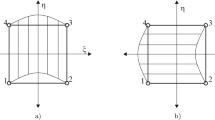Abstract
A closed-form expression for the dual of dissipation potential is derived within the framework of irreversible thermodynamics using the principles of dimensional analysis and self-similarity. Through this potential, a damage evolution law is proposed for concrete under fatigue loading using the concepts of damage mechanics in conjunction with fracture mechanics. The proposed law is used to compute damage in a volume element when a member is subjected to fatigue loading. The evolution of damage from microcracking to macrocracking of the entire member is captured through a series of volume elements failing one after the other. The number of loading cycles to failure of the member is obtained as the summation of number of cycles to failure for each individual volume element. A parametric study is conducted to determine the effect of the size of the volume element on the model’s prediction of fatigue life. A global damage index is also defined, and the residual moment carrying capacity of damaged beams is evaluated. Through a deterministic sensitivity analysis, it is found that the load range and maximum aggregate size are the most influencing parameters on the fatigue life of a plain concrete beam.











Similar content being viewed by others
References
Barenblatt, G.: Scaling, Self-similarity and Intermediate Asymptotic. Cambridge University Press, New York (1996)
Bazant, Z.P., Cabot, G.P.: Measurement of characteristic length of nonlocal continuum. J. Eng. Mech. ASCE 115(4), 755–767 (1989)
Bazant, Z.P., Xu, K.: Size effect in fatigue fracture of concrete. ACI Mater. J. 88(4), 390–399 (1991)
Bhattacharya, B., Ellingwood, B.: Continuum damage mechanics analysis of fatigue crack initiation. Int. J. Fatigue 20(9), 631–639 (1998)
Bonora, N.: A nonlinear CDM model for ductile failure. Eng. Fract. Mech. 58, 11–28 (1997)
Chandrakanth, S., Pandey, P.: An isotropic damage model for ductile material. Eng. Fract. Mech. 50, 457–465 (1995)
Chow, C.L., Wei, Y.: A damage mechanics model of fatigue crack initiation in notched plates. Theoret. Appl. Fract. Mech. 16, 123–133 (1991)
Desmorat, R.: Unified framework for damage and fatigue of metals, concrete and elastomers. In: ICF 11–11th International Conference on Fracture. Turin, Italy (2005)
Eschenbach, T.G.: Spiderplots versus tornado diagrams for sensitivity analysis. Interfaces 22(6), 40–46 (1992)
Fathima, K.P., Kishen, J.C.: A thermodynamic framework for fatigue crack growth in concrete. Int. J. Fatigue 54, 17–24 (2013)
Irwin, G.R.: Analysis of Stresses and Strains Near the End of a Crack Traversing a Plate. J. Appl. Mech. (1957)
Kachanov, L.M.: On the time to rupture under creep conditions. Izv. Acad. Nauk SSR, OTN 8, 26–31 (1958)
Krajcinovic, D.: Damage mechanics. Mech. Mater. 8, 117–197 (1989)
Lemaitre, J.: How to use damage mechanics. Nucl. Eng. Des. 80(2), 233–245 (1984)
Lemaitre, J.: A continuum damage mechanics model for ductile fracture. J. Eng. Mater. Technol. 107, 83–89 (1985)
Lemaitre, J.: A Course on Damage Mechanics. Springer, Berlin (1992)
Lemaitre, J., Chaboche, J.: Mechanics of Solid Materials. Cambridge University Press, Cambridge (1990)
Lemaitre, J., Dufailly, J.: Damage measurements. Eng. Fract. Mech. 28(5–6), 643–661 (1987)
Paris, P., Erdogan, F.: A critical analysis of crack propagation laws. J. Basic Eng. 85(4), 528–533 (1963)
Shah, S.G.: Fracture and fatigue behavior of concrete-concrete interfaces using acoustic emission, digital image correlation and micro-indentation techniques. Ph.D. thesis, Department of Civil Engineering, Indian Institute of Science, Bangalore, India (2009)
Shah, S.P., Swartz, S.E., Ouyang, C.: Fracture Mechanics of Concrete: Applications of Fracture Mechanics to Concrete, Rock and Other Quasi-Brittle Materials. Wiley, New York (1995)
Stolkarts, V., Keer, L.M., Fine, M.E.: Damage evolution governed by microcrack nucleation with application to the fatigue of 63sn-37pb solder. J. Mech. Phys. solids 47, 2451–2468 (1999)
Tai, W.: Plastic damage and ductile fracture in mild steels. Eng. Fract. Mech. 37, 853–880 (1990)
Wang, T.: Unified CDM model and local criterion for ductile fracture I. Eng. Fract. Mech. 42(1), 177–183 (1992)
Zia, R.K.P., Redish, E.F., McKay, S.R.: Making sense of the legendre transform. Am. J. Phys. 77(7), 614–622 (2009)
Author information
Authors and Affiliations
Corresponding author
Rights and permissions
About this article
Cite this article
Fathima, K.M.P., Kishen, J.M.C. A thermodynamic framework for the evolution of damage in concrete under fatigue. Arch Appl Mech 85, 921–936 (2015). https://doi.org/10.1007/s00419-015-1001-z
Received:
Accepted:
Published:
Issue Date:
DOI: https://doi.org/10.1007/s00419-015-1001-z




